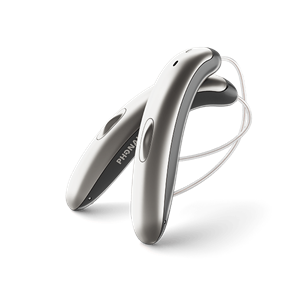What are ear infections? | Connect Hearing

What are ear infections? | Connect Hearing
10 min.
Publication Date: July 18, 2019
Ear infections are so common that 50 percent of children in Canada had suffered from an ear infection between the ages two to seven. According to Statistics Canada*, 13 percent of children in Canada are at risk of an ear infection.
What are the Main Types of Ear Infections?
There are two main types of ear infections. The first is called outer ear infection, also known as otitis externa or swimmer's ear. It affects the ear canal, which goes from the ear opening to the eardrum. An outer ear infection occurs when water enters the ear canal and becomes trapped there by wax build-up. This creates an ideal environment for bacteria to flourish. The body responds to the infection with inflammation, pain, redness, and sometimes a fever.
The second type is called a middle-ear infection or otitis media. It occurs when either virus or bacteria cause infection in the middle ear. The condition is a result of the tubes inside the ears becoming clogged with mucus and fluid. Middle ear infections can be excruciating and are often accompanied by high fever, hearing difficulty, nausea, and vomiting. The fluid build-up can lead to hearing loss as all that ear fluid prevents sound from getting through.
This type of ear infection is much more common, particularly in very young children and infants. When babies and young children pull or slap at their ears, an ear infection is quite possible. Most middle ear infections are linked to an upper respiratory infection or an allergy. Forty percent of cases are thought to be caused by bacteria, the rest by a virus.
How Many Types of Otitis Media are there?
There are two main types of otitis media:
Acute Otitis Media (AOM) -
Acute otitis media comes on rapidly and is defined by swelling and redness in the ear behind and around the eardrum. Ear pain, fever, and partial or complete hearing loss often occur as a result of fluid or mucus caught in the middle ear.
Recurrent acute otitis media –
Repeated episodes of middle ear infections are called recurrent acute otitis media.
Otitis Media with Effusion (OME) -
OME is the presence of fluid in the middle ear without any signs or symptoms of acute infection. This can happen when the infection clears up, but mucus and fluid continue to build up in the middle ear. This build-up creates a feeling of fullness in the ear, reducing your ability to hear clearly. OMEs typically resolve on their own.
Chronic otitis media with effusion –
OME is said to be chronic when middle ear effusion has been present for at least three months.
Other Symptoms of Middle Ear Infection
These are some of the most common symptoms of otitis media. Not all of them need to be present for a diagnosis of ear infection.
- Ear pain, often throbbing
- Fever
- Pressure or a feeling of fullness in the ear
- Pus from the ear
- Hearing difficulty in the affected ear
- Nausea and vomiting
Why Do Children Get Otitis Media So Often?
One of the reasons infants and young children get otitis media so often is connected to the eustachian tube, the passage that leads from the pharynx to the cavity of the middle ear. Because the eustachian tube is more horizontal in children than it is in adults, it prevents fluid to flow smoothly. When it isn’t working properly, mucus is unable to drain from behind the eardrum. Instead it stays stuck and causes pain and pressure, often leading to infection. As children get older, the eustachian tube becomes more vertical and begins to drain better.
How To Prevent Otitis Media?
The answer to preventing otitis media is to limit the build-up of fluid. Having a proper diet can play an essential role in reducing risks. Food allergens, such as cow's milk and sugar, lead to excess mucus and fluid. Eliminating these foods from our diet can be incredibly helpful.
Reducing exposure to environmental allergens, such as second-hand smoke, is also essential. Cigarette smoke creates an environment for bacteria and virus to thrive.
Diagnostics and Treatment
It is essential to take all ear infections and ear pain seriously. A paediatrician or an ENT (Ears, Nose and Throat) doctor is most qualified to make the diagnosis of otitis media. They have the proper instruments to look inside the ear. If you have an acute middle ear infection, your eardrum will be very red. If there is pus present in your middle ear as a result of the infection, the eardrum will bulge slightly forward. This bulging leads to an increased risk of eardrum perforation.
To protect your eardrum from rupturing and speed up the healing process, the doctor may prescribe medications. Over-the-counter ear drops or prescription or antibiotics may be recommended. While the acute inflammatory phase lasts about two to three days, the entire healing process takes about eight weeks. Medications, when prescribed appropriately, can shorten the duration of the infection.
To be on the safe side, be sure to visit your ENT if you have ear pain or hearing loss. Be especially alert for signs of middle ear infections with babies and young children, who often pull on their ears when suffering from ear pain, and consult your doctor as soon as possible.
As a large percentage of otitis media is viral, antibiotic therapies are not always the appropriate course of treatment. Your doctor can determine whether the likelihood of bacterial or viral infection is higher based on your symptoms. You can try to alleviate the symptoms of middle ear infection with home remedies.
Home Remedies for Otitis Media
There are several things you can do to help relieve your symptoms related to a middle ear infection. Increasing your water intake is one important step you can take to assist your body with clearing the infection. You should drink plenty of water to help flush bacteria and viruses out of the body. Although alternative therapies and home remedies are to ease discomfort, they are not recommended for children.
One popular home remedy you can find online is for onion poultices that are said to relieve ear pain. While there is little to no scientific agreement on the effectiveness of onion poultices, there are some things you can do to help ease infection.
Please remember, you should never delay seeking medical attention if the fever does not subside or if the ear continues to hurt. While home remedies can be quite helpful, they do not replace the need for a doctor’s visit.
Diet
Diet doesn’t essentially relieve symptoms when the infection is present. However, it can prevent recurring infections. Follow these dietary suggestions to help alleviate pain and prevent recurring infections. You may need to make drastic changes in your child's diet for optimal results.
Recommended Foods
You can use these foods to prevent recurring ear infections and strengthen your immune system.
- Follow a healthy diet centered around fresh fruits, vegetables, whole grains, and high-quality protein, will make your immune system stronger.
- Drink plenty of clean, quality water to thin mucus secretions.
- Essential fatty acids, found in cold-water fish, flaxseeds, and flaxseed oil, are useful in reducing the inflammation or the allergies that are often present.
- Switch bottle-fed babies to a non-dairy formula, with your doctor's supervision.
- Breastfeeding mothers should avoid common allergens, such as cow's milk.
Other Recommendations
- Do not bottle-feed while children are lying on their backs. They should be at a thirty-degree angle or more to prevent fluid accumulation in the eustachian tube.
- Do not smoke or expose yourself or your child to second-hand smoke.
- Avoid using cotton swabs, as they pack wax into the ear canal.
- During an infection, don't allow moisture into your ears.
- To decrease pain, apply heat locally. Try a hot-water bottle wrapped in a towel.
- Use over-the-counter eardrops with a local anesthetic to prevent infection in your ears.
Complications
Pressure equalization tubes and perforations often cause middle ear infection. This results in scarring of the eardrum. The formation of scar tissue on the eardrum is one such complication. The scar tissue can lead to hearing difficulty, untreated otitis media, and eventually ruptured eardrums. If the tiny ear bones called ossicles in your ear are damaged or deformed, this can cause hearing loss.
The high potential for complications makes a diagnosis by a doctor critical. Never disregard ear pain or hearing loss, and consult an ear, nose and throat specialist immediately.
Read more to learn what to expect when you visit a hearing care professional.
Do you have questions or concerns about your hearing loss?
Get your hearing tested at one of our hearing clinics near you.
Recent trends in upper respiratory infections, ear infections and asthma among young Canadian children, (2015, July 17), Retrieved from https://www150.statcan.gc.ca/n1/pub/82-003-x/2010004/article/11364/findings-resultats-eng.htm



